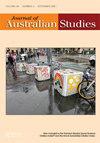By Students for Students: A History of the Melbourne University Union
IF 0.4
3区 历史学
Q3 AREA STUDIES
引用次数: 0
Abstract
meaningful insights from. Isolated examples, however, reveal audience members’ devotion to particular programs or personalities, even requesting dates with television stars. The fan mail received by satirical radio and television personalities Roy Slaven (John Doyle) and H. G. Nelson (Greig Pickhaver), for example, reveal a rich sense of community and audience involvement in the duo’s programs, commentary and humour. Like the record of complaints received by broadcasters, personalities and programs, the sheer volume of letter writing indicates Australians’ keen dedication to the form, and indeed a “proprietorial feeling” (86) listeners had for their local radio stations, if not for programs and personalities themselves. Complaints about unscripted banter on television reveal a preoccupation with morality and “good taste”, most famously in the case of Graham Kennedy’s 1975 “crow call”. These letters, Griffen-Foley argues, constitute the “voices of Australians... lonely, sad, angry, indignant and sometimes funny” as they “negotiated questions of cultural, power and value over a century” (96). A tantalising examination of ABC Television Viewers’ Committees from 1959 to 1965 reveals the operations of an early experiment in the ABC’s efforts at audience consultation. Its findings suggest the two-way interaction between broadcaster and audience was limited, however, amid a lack of interest in audience input on programming. The final chapter on matchmaking programs on radio and television explores a popular genre of entertainment from the 1930s to the 1980s, which paved the way for much reality television. Here, audience involvement in particular programs was more literal, especially on television, where participation by “ordinary” viewers in a show such as Perfect Match offered an inkling of celebrity. One wishes the book’s introduction and conclusion were slightly longer, and indeed the book itself had more stories to tell. As Griffen-Foley admits, its contents serve as an invitation for media historians to delve deeper into these areas, where unexamined files and private archives promise to reveal new findings on the operation of Australian media institutions and those Australians who consumed its programming over the last century.《学生为学生:墨尔本大学联盟的历史》
有意义的见解来自。然而,个别例子显示,观众对特定节目或人物的热爱,甚至要求与电视明星约会。例如,讽刺广播和电视名人罗伊·斯莱文(约翰·道尔饰)和h·g·纳尔逊(格雷格·匹克哈弗饰)收到的粉丝邮件显示,他们在节目、评论和幽默中有着丰富的社区意识和观众参与感。就像广播公司、名人和节目收到的投诉记录一样,大量的信件表明澳大利亚人对这种形式的热切奉献,以及听众对当地广播电台的一种“专属感”(86),如果不是对节目和节目本身的话。对电视上没有剧本的玩笑的抱怨揭示了对道德和“好品味”的关注,最著名的例子是格雷厄姆·肯尼迪1975年的“乌鸦叫”。格里芬-福利认为,这些信件构成了“澳大利亚人的声音……孤独、悲伤、愤怒、愤慨,有时甚至滑稽”,因为他们“在一个世纪的时间里就文化、权力和价值问题进行了谈判”(96页)。对1959年至1965年美国广播公司电视观众委员会进行的一项诱人的调查揭示了美国广播公司在观众咨询方面的早期实验的运作。调查结果表明,由于观众对节目投入缺乏兴趣,广播公司和观众之间的双向互动是有限的。最后一章是关于广播和电视上的相亲节目,探讨了20世纪30年代到80年代流行的娱乐类型,这为许多真人秀电视铺平了道路。在这里,观众对特定节目的参与更多是字面上的,尤其是在电视上,“普通”观众参与《完美匹配》这样的节目,可以让人隐约感受到名人的存在。人们希望这本书的引言和结束语稍微长一点,而且这本书本身也有更多的故事要讲。正如Griffen-Foley承认的那样,它的内容对媒体历史学家来说是一种邀请,可以更深入地研究这些领域,在这些领域,未经审查的文件和私人档案有望揭示澳大利亚媒体机构运作的新发现,以及上个世纪收看其节目的澳大利亚人。
本文章由计算机程序翻译,如有差异,请以英文原文为准。
求助全文
约1分钟内获得全文
求助全文
来源期刊

Journal of Australian Studies
Multiple-
CiteScore
0.90
自引率
20.00%
发文量
56
期刊介绍:
The Journal of Australian Studies (JAS) is the journal of the International Australian Studies Association (InASA). In print since the mid-1970s, in the last few decades JAS has been involved in some of the most important discussion about the past, present and future of Australia. The Journal of Australian Studies is a fully refereed, international quarterly journal which publishes scholarly articles and reviews on Australian culture, society, politics, history and literature. The editorial practice is to promote and include multi- and interdisciplinary work.
 求助内容:
求助内容: 应助结果提醒方式:
应助结果提醒方式:


